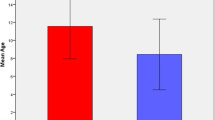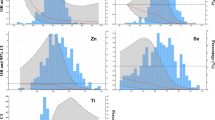Abstract
Helicobacter pylori (H. pylori) infection can interfere with the absorption of most elements, and the variations of some element levels are related to the incidence of gastric cancer. However, there have been conflicting results concerning the influence of H. pylori infection on serum element levels. The present study aimed to compare the serum element concentrations of H. pylori-infected local residents with uninfected residents from Lujiang County with high gastric cancer risk in Eastern China. We used data and serum samples from the H. pylori screening-survey program which was a cross-sectional study. We took 155 samples randomly from the screening survey, identified 74 H. pylori-positive residents and 81 H. pylori-negative residents by a serological test. The serum concentrations of 15 elements (calcium, magnesium, iron, zinc, selenium, copper, molybdenum, chromium, cobalt, nickel, lead, cadmium, mercury, arsenic, and aluminum) were determined using inductively coupled plasma mass spectrometry. Serum cobalt was found at higher levels in the H. pylori-infected residents than the H. pylori-uninfected residents (0.246 vs 0.205 μg/L, P = 0.022), but no statistically significant differences in the serum levels of other elements were found. This is the first study to report the serum concentrations of 15 elements and their relationships with the infection status of H. pylori among local residents from Lujiang County with high gastric cancer risk. Although the International Agency for Research on Cancer has classified cobalt and other soluble cobalt salts as possibly carcinogenic to human beings, our results may provide a clue to the relationships between cobalt, H. pylori, and gastric cancer.

Similar content being viewed by others
References
Torre LA, Bray F, Siegel RL, Ferlay J, Lortet-Tieulent J, Jemal A (2015) Global cancer statistics, 2012. CA Cancer J Clin 65(2):87–108. https://doi.org/10.3322/caac.21262
Pan R, Zhu M, Yu C, Lv J, Guo Y, Bian Z, Yang L, Chen Y, Hu Z, Chen Z, Li L, Shen H (2017) Cancer incidence and mortality: a cohort study in China, 2008–2013. Int J Cancer 141(7):1315–1323. https://doi.org/10.1002/ijc.30825
Chen W, Zheng R, Baade PD, Zhang S, Zeng H, Bray F, Jemal A, Yu XQ, He J (2016) Cancer statistics in China, 2015. CA Cancer J Clin 66(2):115–132. https://doi.org/10.3322/caac.21338
Yang L (2006) Incidence and mortality of gastric cancer in China. World J Gastroenterol 12(1):17–20
Hongyu C, Shuang J, Haiting C, Ran C, Xiaowen D, Guanglie H, Fen H (2015) Analysis of cancer prevalence in Lujiang county of Anhui Province during 2010–2012. Chin J Prevent Control Chronic Dis 23(2):113–115
Plummer M, Franceschi S, Vignat J, Forman D, de Martel C (2015) Global burden of gastric cancer attributable to Helicobacter pylori. Int J Cancer 136(2):487–490. https://doi.org/10.1002/ijc.28999
Lahner E, Persechino S, Annibale B (2012) Micronutrients (other than iron) and Helicobacter pylori infection: a systematic review. Helicobacter 17(1):1–15. https://doi.org/10.1111/j.1523-5378.2011.00892.x
Mark SD, Qiao YL, Dawsey SM, Wu YP, Katki H, Gunter EW, Fraumeni JF Jr, Blot WJ, Dong ZW, Taylor PR (2000) Prospective study of serum selenium levels and incident esophageal and gastric cancers. J Natl Cancer Inst 92(21):1753–1763
Wei WQ, Abnet CC, Qiao YL, Dawsey SM, Dong ZW, Sun XD, Fan JH, Gunter EW, Taylor PR, Mark SD (2004) Prospective study of serum selenium concentrations and esophageal and gastric cardia cancer, heart disease, stroke, and total death. Am J Clin Nutr 79(1):80–85
Pra D, Rech Franke SI, Pegas Henriques JA, Fenech M (2009) A possible link between iron deficiency and gastrointestinal carcinogenesis. Nutr Cancer 61(4):415–426. https://doi.org/10.1080/01635580902803701
Cao GH, Yan SM, Yuan ZK, Wu L, Liu YF (1998) A study of the relationship between trace element Mo and gastric cancer. World J Gastroenterol 4(1):55–56
Wu MC, Huang CY, Kuo FC, Hsu WH, Wang SS, Shih HY, Liu CJ, Chen YH, Wu DC, Huang YL, Lu CY (2014) The effect of Helicobacter pylori eradication on the levels of essential trace elements. Biomed Res Int 2014:513725–513725. https://doi.org/10.1155/2014/513725
Abbasciano V, Sartori S, Trevisani L, Girometti R, Ranzini M, Nielsen I, Mazzotta D, Vecchiatti G, Bononi A, Guglielmini C (2003) Comparison of magnesium concentration in serum, erythrocytes and gastric tissue in two groups of patients affected by chronic gastritis, Helicobacter pylori negative and positive. Magnes Res 16(4):281–286
Janjetic MA, Goldman CG, Balcarce NE, Rua EC, Gonzalez AB, Fuda JA, Meseri EI, Torti HE, Barrado J, Zubillaga MB, Lopez LB, Boccio JR (2010) Iron, zinc, and copper nutritional status in children infected with Helicobacter pylori. J Pediatr Gastroenterol Nutr 51(1):85–89. https://doi.org/10.1097/MPG.0b013e3181c2c2cd
Ozturk N, Kurt N, Ozgeris FB, Baygutalp NK, Tosun MS, Bakan N, Bakan E (2015) Serum zinc, copper, magnesium and selenium levels in children with helicobacter pylori infection. Eurasian J Med 47(2):126–129. https://doi.org/10.5152/eurasianjmed.2015.104
Dovhanj J, Kljaic K, Vcev A, Ilakovac V (2010) Helicobacter pylori and trace elements. Clin Lab 56(3–4):137–142
Yuan W, Yang N, Li X (2016) Advances in understanding how heavy metal pollution triggers gastric cancer. Biomed Res Int 2016:7825432–7825410. https://doi.org/10.1155/2016/7825432
Zhao Q, Wang Y, Cao Y, Chen A, Ren M, Ge Y, Yu Z, Wan S, Hu A, Bo Q, Ruan L, Chen H, Qin S, Chen W, Hu C, Tao F, Xu D, Xu J, Wen L, Li L (2014) Potential health risks of heavy metals in cultivated topsoil and grain, including correlations with human primary liver, lung and gastric cancer, in Anhui province, Eastern China. Sci Total Environ 470-471:340–347. https://doi.org/10.1016/j.scitotenv.2013.09.086
Liang C, Li Z, Xia X, Wang Q, Tao R, Tao Y, Xiang H, Tong S, Tao F (2017) Determine multiple elements simultaneously in the sera of umbilical cord blood samples—a very simple method. Biol Trace Elem Res 177(1):1–8. https://doi.org/10.1007/s12011-016-0853-6
Yuehong W, Zhu G, Nong X, Yijia W, Hua L (2005) A case-control study on the relationship between self-made foods and gastric cancer in rural areas. Ji bing kong zhi za zhi [Chin J Dis Control Prev] 9(5):387–389
Matsuda T, Tao H, Goto M, Yamada H, Suzuki M, Wu Y, Xiao N, He Q, Guo W, Cai Z, Kurabe N, Ishino K, Matsushima Y, Shinmura K, Konno H, Maekawa M, Wang Y, Sugimura H (2013) Lipid peroxidation-induced DNA adducts in human gastric mucosa. Carcinogenesis 34(1):121–127. https://doi.org/10.1093/carcin/bgs327
Cai X, Wang C, Yu W, Fan W, Wang S, Shen N, Wu P, Li X, Wang F (2016) Selenium exposure and cancer risk: an updated meta-analysis and meta-regression. Sci Rep 6:19213. https://doi.org/10.1038/srep19213
Qiao YL, Dawsey SM, Kamangar F, Fan JH, Abnet CC, Sun XD, Johnson LL, Gail MH, Dong ZW, Yu B, Mark SD, Taylor PR (2009) Total and cancer mortality after supplementation with vitamins and minerals: follow-up of the Linxian General Population Nutrition Intervention Trial. J Natl Cancer Inst 101(7):507–518. https://doi.org/10.1093/jnci/djp037
Compounds IoMUPoDAaR (2000) Selenium. In: Dietary reference intakes for vitamin C, vitamin E, selenium, and carotenoids. National Academies Press (US), Washington (DC). https://doi.org/10.17226/9810
Manz DH, Blanchette NL, Paul BT, Torti FM, Torti SV (2016) Iron and cancer: recent insights. Ann N Y Acad Sci 1368(1):149–161. https://doi.org/10.1111/nyas.13008
Wen CP, Lee JH, Tai YP, Wen C, Wu SB, Tsai MK, Hsieh DP, Chiang HC, Hsiung CA, Hsu CY, Wu X (2014) High serum iron is associated with increased cancer risk. Cancer Res 74(22):6589–6597. https://doi.org/10.1158/0008-5472.CAN-14-0360
Kisker C, Schindelin H, Rees DC (1997) Molybdenum-cofactor-containing enzymes: structure and mechanism. Annu Rev Biochem 66:233–267. https://doi.org/10.1146/annurev.biochem.66.1.233
Luo XM, Wei HJ, Yang SP (1983) Inhibitory effects of molybdenum on esophageal and forestomach carcinogenesis in rats. J Natl Cancer Inst 71(1):75–80
Cai L, Chen T, Yang J, Zhou K, Yan X, Chen W, Sun L, Li L, Qin S, Wang P, Yang P, Cui D, Burmeister M, He L, Jia W, Wan C (2015) Serum trace element differences between Schizophrenia patients and controls in the Han Chinese population. Sci Rep 5:15013. https://doi.org/10.1038/srep15013
Ceylan OM, Can Demirdogen B, Mumcuoglu T, Aykut O (2013) Evaluation of essential and toxic trace elements in pseudoexfoliation syndrome and pseudoexfoliation glaucoma. Biol Trace Elem Res 153(1–3):28–34. https://doi.org/10.1007/s12011-013-9644-5
Garcia-Esquinas E, Pollan M, Umans JG, Francesconi KA, Goessler W, Guallar E, Howard B, Farley J, Best LG, Navas-Acien A (2013) Arsenic exposure and cancer mortality in a US-based prospective cohort: the strong heart study. Cancer Epidemiol Biomark Prev 22(11):1944–1953. https://doi.org/10.1158/1055-9965.EPI-13-0234-T
Garcia-Esquinas E, Pollan M, Tellez-Plaza M, Francesconi KA, Goessler W, Guallar E, Umans JG, Yeh J, Best LG, Navas-Acien A (2014) Cadmium exposure and cancer mortality in a prospective cohort: the strong heart study. Environ Health Perspect 122(4):363–370. https://doi.org/10.1289/ehp.1306587
Berg JW, Burbank F (1972) Correlations between carcinogenic trace metals in water supplies and cancer mortality. Ann N Y Acad Sci 199:249–264
Lhotka C, Szekeres T, Steffan I, Zhuber K, Zweymuller K (2003) Four-year study of cobalt and chromium blood levels in patients managed with two different metal-on-metal total hip replacements. J Orthop Res 21(2):189–195. https://doi.org/10.1016/S0736-0266(02)00152-3
Hutter HP, Wallner P, Moshammer H, Marsh G (2016) Dust and cobalt levels in the Austrian tungsten industry: workplace and human biomonitoring data. Int J Environ Res Public Health 13(9):931. https://doi.org/10.3390/ijerph13090931
Lison D, De Boeck M, Verougstraete V, Kirsch-Volders M (2001) Update on the genotoxicity and carcinogenicity of cobalt compounds. Occup Environ Med 58(10):619–625
Liu LZ, Ding M, Zheng JZ, Zhu Y, Fenderson BA, Li B, Yu JJ, Jiang BH (2015) Tungsten carbide-cobalt nanoparticles induce reactive oxygen species, AKT, ERK, AP-1, NF-kappaB, VEGF, and angiogenesis. Biol Trace Elem Res 166(1):57–65. https://doi.org/10.1007/s12011-015-0331-6
Moulin JJ, Wild P, Romazini S, Lasfargues G, Peltier A, Bozec C, Deguerry P, Pellet F, Perdrix A (1998) Lung cancer risk in hard-metal workers. Am J Epidemiol 148(3):241–248
Sauni R, Oksa P, Uitti J, Linna A, Kerttula R, Pukkala E (2017) Cancer incidence among Finnish male cobalt production workers in 1969–2013: a cohort study. BMC Cancer 17(1):340. https://doi.org/10.1186/s12885-017-3333-2
Choi R, Kim HT, Lim Y, Kim MJ, Kwon OJ, Jeon K, Park HY, Jeong BH, Koh WJ, Lee SY (2015) Serum concentrations of trace elements in patients with tuberculosis and its association with treatment outcome. Nutrients 7(7):5969–5981. https://doi.org/10.3390/nu7075263
Karadas S, Sayin R, Aslan M, Gonullu H, Kati C, Dursun R, Duran L, Gonullu E, Demir H (2014) Serum levels of trace elements and heavy metals in patients with acute hemorrhagic stroke. J Membr Biol 247(2):175–180. https://doi.org/10.1007/s00232-013-9621-0
Mohmand J, Eqani SA, Fasola M, Alamdar A, Mustafa I, Ali N, Liu L, Peng S, Shen H (2015) Human exposure to toxic metals via contaminated dust: bio-accumulation trends and their potential risk estimation. Chemosphere 132:142–151. https://doi.org/10.1016/j.chemosphere.2015.03.004
Bruggraber SF, French G, Thompson RP, Powell JJ (2004) Selective and effective bactericidal activity of the cobalt (II) cation against Helicobacter pylori. Helicobacter 9(5):422–428. https://doi.org/10.1111/j.1083-4389.2004.00264.x
Jing C, Wang C, Yan K, Zhao K, Sheng G, Qu D, Niu F, Zhu H, You Z (2016) Synthesis, structures and urease inhibitory activity of cobalt(III) complexes with Schiff bases. Bioorg Med Chem 24(2):270–276. https://doi.org/10.1016/j.bmc.2015.12.013
Funding
This study was funded by the National Natural Science Foundation of China (No. 81502806) and Grant for Scientific Research of BSKY from Anhui Medical University (No. XJ201523).
Author information
Authors and Affiliations
Corresponding author
Ethics declarations
This study received ethical approval from the Ethics Institutional Review Board from the Anhui Medical University. Written informed consents were obtained from all participants before taking part in the study.
Conflict of Interest
The authors declare that they have no conflict of interest.
Rights and permissions
About this article
Cite this article
Hu, A., Li, L., Hu, C. et al. Serum Concentrations of 15 Elements Among Helicobacter Pylori-Infected Residents from Lujiang County with High Gastric Cancer Risk in Eastern China. Biol Trace Elem Res 186, 21–30 (2018). https://doi.org/10.1007/s12011-018-1283-4
Received:
Accepted:
Published:
Issue Date:
DOI: https://doi.org/10.1007/s12011-018-1283-4




